You’ll need a high-precision faceting machine with a 220-watt brushless motor and 96-position indexing system for exact angle control. Essential tools include diamond cutting laps with variable grits (80-1200), specialized polishing laps like Spectra Ultralaps, and premium compounds like cerium oxide for quartz. Don’t forget precision measurement tools, digital calipers, quality dop sticks, adjustable LED lighting systems, and extensive safety equipment. Each component works together to achieve professional-grade results that’ll transform your gemstone cutting capabilities completely.
High-Precision Faceting Machines With Variable Speed Control
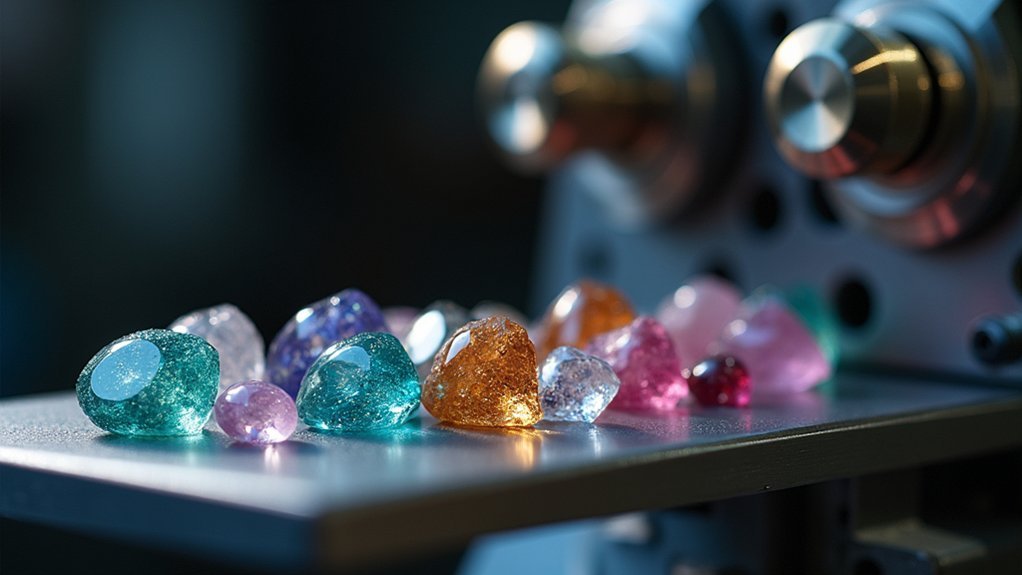
Precision defines the difference between amateur and professional gem faceting, and high-precision faceting machines with variable speed control deliver the exacting standards you need.
These advanced machines feature a powerful 220-watt brushless DC motor that provides variable speed control up to 3000 RPM, allowing you to make fine adjustments throughout the cutting process.
You’ll benefit from the direct-drive system that eliminates belts and pulleys, ensuring minimal noise and maximum efficiency at any operating speed.
The 96 indexing gear system enables precise facet arrangement, while the adjustable mast and angle settings provide smooth movement for customized cutting angles.
User-friendly features include an indicator dial for angle accuracy feedback and adjustable LED lamps that enhance visibility during your faceting machine operations.
Professional Diamond Cutting Laps for Superior Material Removal
You’ll need to master three critical aspects when selecting professional diamond cutting laps for ideal performance.
First, understanding diamond grit selection guarantees you’re using the right aggressiveness for each stage, from 260 grit for initial shaping to 1,200 grit for fine polishing.
Additionally, enhancing lap speed and applying material-specific cutting techniques will maximize your efficiency while preventing costly damage to your gemstones.
Diamond Grit Selection Guide
Understanding diamond grit sizes forms the foundation of successful gem faceting, as each grit serves a distinct purpose in transforming rough stones into polished gems. You’ll need different diamond grit options for your faceting machines to achieve professional results efficiently.
| Grit Size | Purpose |
|---|---|
| 80-100 | Rapid material removal and initial shaping |
| 600-1200 | Fine finishing and polishing |
| Variable | Match to gemstone hardness for ideal results |
Lower grits handle aggressive cutting, while higher grits deliver mirror-like finishes. You must match your grit selection to your gemstone’s hardness—finer grits work best on sapphires and rubies. Regular maintenance keeps your diamond grit performing effectively. Investing in various grit options ensures you’ll tackle any faceting project with confidence and precision.
Lap Speed Optimization
Professional diamond cutting laps achieve peak performance through precise speed control that matches your gemstone’s hardness and cutting stage.
You’ll want to adjust your lap speed efficiency settings from 0 to 3000 RPM based on material density and desired finish quality. Higher speeds work exceptionally well on harder materials like quartz and beryl, accelerating your progress through coarse, medium, and fine cutting stages.
Your solid steel laps require different speeds for ideal cutting and polishing results. Use moderate speeds for 260 grit coarse cutting, then increase velocity for 1200 grit fine work.
Always maintain your controlled water drip system during operation to prevent overheating.
- Match lap speeds to gemstone hardness levels for maximum efficiency
- Increase RPM progressively from coarse to fine cutting stages
- Monitor water cooling systems to maintain consistent temperature control
Material-Specific Cutting Techniques
Master your gemstone cutting by selecting diamond laps specifically engineered for each material’s unique properties.
You’ll achieve superior material removal rates when working with hard stones like diamonds and sapphires by using professional diamond cutting laps featuring embedded diamond grit in a durable metal matrix.
Start your cutting process with a coarse lap around 260 grit for initial shaping and material removal. This aggressive cutting stage removes excess material quickly while maintaining precision.
Follow with progressively finer grits—600 and 1,200—transitioning to your polishing lap for that final mirror finish.
Always keep your laps wet with proper lubricant to minimize friction and prevent damage to both your equipment and gemstone.
This material-specific approach dramatically increases cutting speed while reducing the risk of stone damage during faceting.
Specialized Polishing Laps for Mirror-Like Gemstone Finishes
Achieving a flawless, mirror-like finish on your gemstones requires the right polishing laps paired with appropriate compounds. Specialized options like Spectra Ultralaps deliver exceptional results for quartz and beryl when you charge them correctly.
You’ll want to use dedicated laps for cerium oxide and alumina oxide polishes to prevent cross-contamination that compromises your gemstone’s finish.
Consider Lucite laps as alternatives for specific materials, while tin laps work best for tourmaline and garnet. Your lap selection should match your cutting stage—finer grits during final polishing enhance brilliance and clarity.
Regular maintenance is essential; properly clean and recharge your laps to sustain effectiveness throughout your gemstone faceting process.
- Match lap material to gemstone type for ideal polishing results
- Prevent contamination by using dedicated laps for different compounds
- Maintain equipment consistently to guarantee mirror-like finishes
Advanced Indexing Systems for Perfect Angle Repeatability
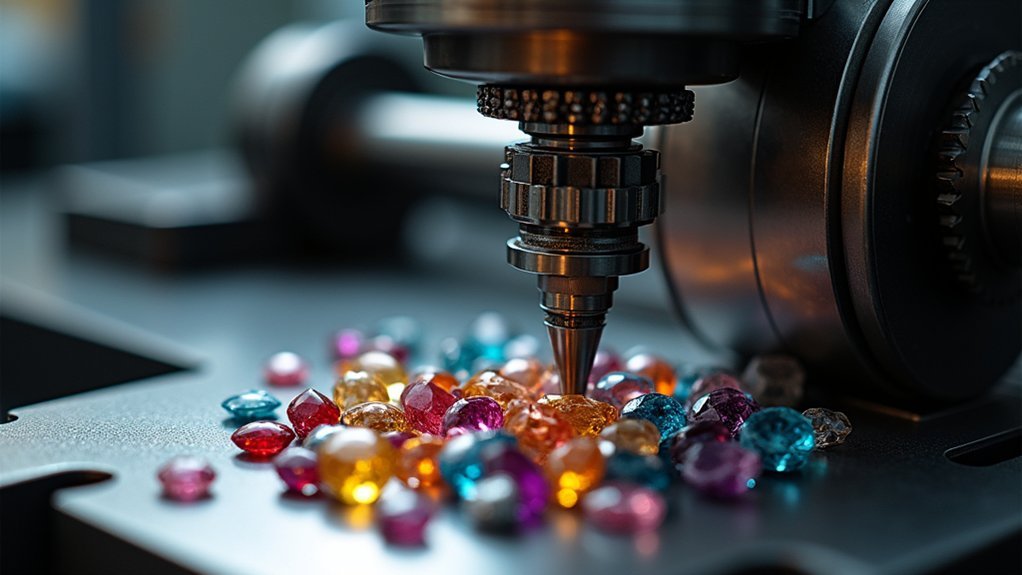
When you’re cutting multiple gemstones that need identical facet angles, advanced indexing systems become your most critical tool for achieving perfect repeatability.
These sophisticated mechanisms feature precision gear systems that allow angle adjustments in increments as fine as 1 degree or smaller, ensuring consistent facet placement across every stone you cut.
You’ll find machines equipped with 64 or 96-position indexing gears that enable diverse facet arrangements while maximizing brilliance.
Digital displays provide real-time feedback during angle adjustments, making precise cuts more accessible even for beginners.
The integrated adjustable arms and locking mechanisms secure your gemstones firmly while allowing smooth movement throughout the faceting process.
This repeatability proves invaluable when creating matching stones for earrings or multi-stone jewelry pieces.
Premium Dop Sticks and Transfer Assemblies for Secure Stone Holding
Perfect angle repeatability means nothing without secure stone holding throughout the entire faceting process.
Premium dop sticks made from brass provide the foundation for precise gemstone control, ensuring your stones won’t slip during critical cutting phases. Keyed dop systems enable fast, accurate attachment while maintaining perfect alignment between transfers.
Your transfer fixture becomes essential when switching stones between different stages of faceting. These assemblies minimize misalignment risks and prevent damage during changes. Various dop stick shapes accommodate different gemstone sizes, giving you versatility across projects.
The included dop transfer jig streamlines your workflow by maintaining ideal positioning and angle settings throughout the process.
- Brass construction delivers superior grip strength and durability for professional results
- Keyed systems eliminate guesswork during stone attachment and removal procedures
- Transfer jigs preserve critical angle settings between cutting sessions
Professional-Grade Oxide Polishes and Compounds
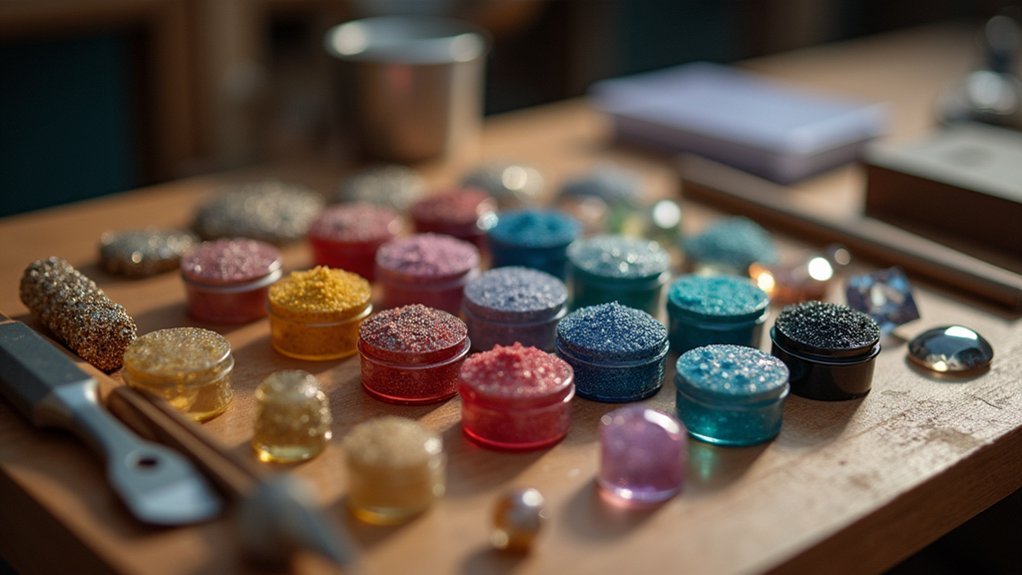
You’ll need professional-grade oxide polishes to achieve that mirror-like finish your gemstones deserve.
Cerium oxide excels at bringing out brilliant clarity in quartz and beryl, while alumina oxide works best for tourmaline and garnet surfaces.
Understanding which compound matches your stone type will make the difference between amateur and professional results.
Cerium Oxide Applications
Although many polishing compounds exist in the gem cutting world, cerium oxide stands out as the gold standard for achieving mirror-like finishes on quartz and beryl gemstones.
You’ll find its fine particle size and high refractive index deliver exceptional results that’ll greatly boost your stones’ market value.
When you’re ready to elevate your polishing process, charge cerium oxide onto a Spectra Ultralap for ideal distribution.
This combination removes microscopic scratches while enhancing optical properties and clarity.
You’ll want high-grade cerium oxide with powdered sugar consistency for professional results.
- Enhanced Market Value: Your finished gemstones command higher prices with superior optical clarity
- Professional Results: Achieve consistent, mirror-like finishes that rival commercial operations
- Versatile Applications: Perfect for both quartz varieties and precious beryl family stones
Alumina Oxide Benefits
When it comes to achieving professional-grade finishes on tourmaline and garnet, alumina oxide polish delivers the consistent high-gloss results that separate amateur work from commercial-quality gemstones. You’ll find this compound’s powdered sugar-like texture reduces surface scratches while enhancing brilliance and fire in your cut gem.
| Material | Grade | Result |
|---|---|---|
| Tourmaline | Fine | High-gloss finish |
| Garnet | Medium | Enhanced brilliance |
| Quartz | Variable | Reduced scratches |
Alumina oxide’s versatility makes it effective across quartz and beryl varieties. You can easily recharge it with Spectra Ultralaps for consistent results. Whether you’re beginning or working professionally, this polish greatly improves your gemstone’s market value and aesthetic appeal through proper application techniques.
Compound Selection Guide
Since different gemstone materials require specific polishing compounds to achieve ideal results, selecting the right oxide polish becomes essential for professional-grade finishes.
Your compound selection guide should prioritize matching each gem material with its corresponding oxide polish. For quartz and beryl, you’ll achieve brilliant finishes using cerium oxide polish, renowned for its high-grade quality.
When working with tourmaline and garnet, alumina oxide delivers superior shine and enhanced appearance.
Both oxides come in fine powder form resembling powdered sugar, ensuring precise application on your polishing laps.
Spectra Ultralaps offer excellent versatility since they’re rechargeable with these oxides for various materials.
- Maintain separate polishing laps for different gem materials to prevent cross-contamination
- Choose cerium oxide for harder materials like quartz and beryl
- Select alumina oxide for tourmaline and garnet applications
Precision Measurement Tools for Accurate Facet Geometry
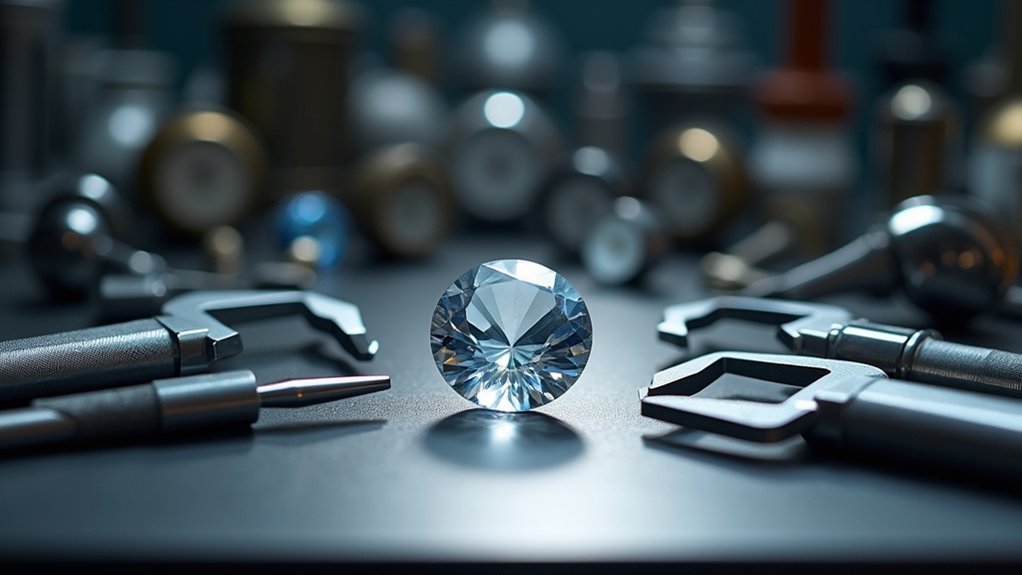
While cutting a gemstone requires steady hands and patience, achieving professional-quality results depends heavily on your precision measurement tools. Digital calipers and protractors are essential for accurately setting facet angles to one decimal place. Even slight deviations can ruin light performance and create dull stones.
| Tool | Purpose | Critical Feature |
|---|---|---|
| Digital Calipers | Measure dimensions | 0.1° precision |
| Index Gears (64/96) | Rotate gemstone | Exact positioning |
| 10X Loupe | Verify geometry | Center facet meeting |
You’ll need regular calibration and maintenance to maintain accuracy throughout your cutting process. Index gears in 64 and 96 sizes enable precise gemstone rotation for perfect facet positioning. Always use your 10X loupe to inspect that facets meet correctly at the center, ensuring your desired geometry is achieved consistently.
High-Quality Lighting Systems for Enhanced Stone Visibility
Three critical factors determine your success in professional gem faceting: precision tools, steady technique, and exceptional lighting.
High-quality lighting systems transform your faceting experience by providing the visibility needed for precise angle adjustments and detailed stone inspections. Adjustable LED lamps with variable brightness reduce glare while revealing surface details and potential flaws that could compromise your final product.
Many modern faceting machines include built-in adjustable LED lights, ensuring consistent illumination regardless of ambient conditions. Proper lighting influences how you perceive color and clarity, enabling informed decisions throughout the cutting process.
Quality illumination proves invaluable during polishing, revealing imperfections that need attention for achieving that brilliant finish.
- Adjustable brightness controls eliminate glare while maximizing surface detail visibility
- Built-in LED systems provide consistent lighting independent of workshop conditions
- Enhanced color perception enables better decision-making during critical cutting stages
Temperature Control Equipment for Optimal Dopping Results
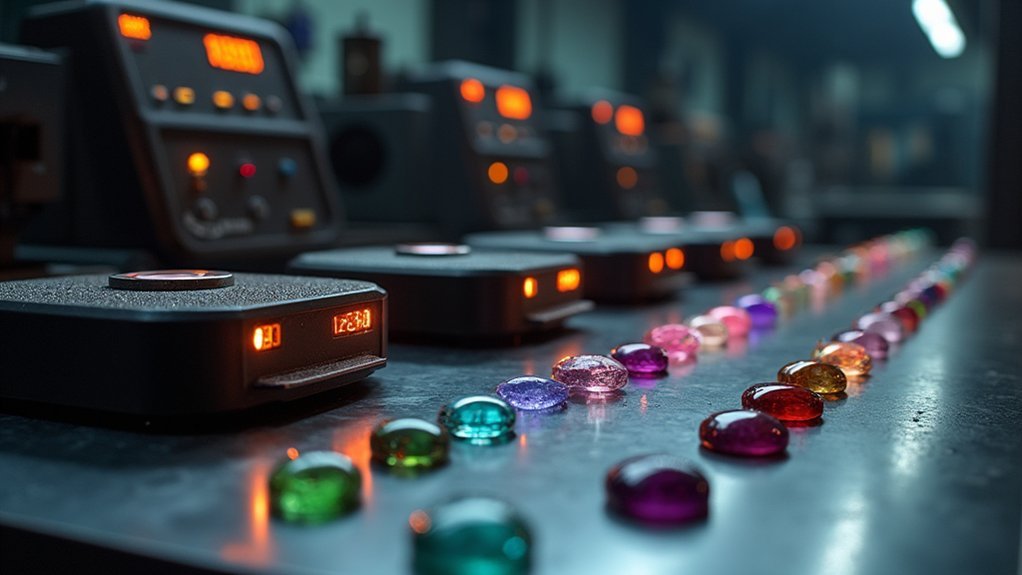
You’ll need reliable temperature control equipment to achieve consistent dopping results that keep your gemstones securely attached throughout the faceting process.
An alcohol lamp provides the steady, controlled heat necessary for initial dopping, while a precision torch becomes essential when you’re transferring stones between different dop sticks.
Mastering these two heat sources will dramatically improve your dopping success rate and prevent costly stone losses during cutting.
Alcohol Lamp Basics
Precision in gemstone faceting begins with mastering your dopping technique, and an alcohol lamp serves as the cornerstone of effective temperature control during this critical process.
You’ll achieve ideal results when your alcohol lamp reaches approximately 1,000°F (538°C), providing the perfect heat for melting high-temperature dop wax without compromising your gemstone’s integrity. This controlled heating environment gives you superior command over the process of cutting compared to alternative heat sources, reducing risks of overheating or burning.
Essential alcohol lamp practices include:
- Maintain proper ventilation – Always operate in well-ventilated areas to prevent harmful fume accumulation
- Monitor fuel levels consistently – Regular refills guarantee uninterrupted heating throughout your dopping sessions
- Control flame positioning – Precise flame placement prevents thermal shock while ensuring complete wax melting
Torch Transfer Techniques
When you’re ready to advance beyond basic alcohol lamp heating, a Blazer torch becomes your most valuable asset for executing precise stone transfers between dops. This specialized torch delivers consistent, adjustable flames that give you superior temperature control throughout the dopping process.
You’ll want high-temperature dop wax for maximum adhesion since it won’t melt under intense heat.
Heat your dop stick evenly to prevent thermal shock that could fracture your gemstone. Keep the torch flame at a safe distance from the stone while maintaining steady hand control to avoid overheating damage.
After each transfer, let the dop wax cool and harden completely before continuing. This guarantees your gemstone stays securely attached during faceting operations.
Essential Safety and Maintenance Equipment for Professional Operations
Although faceting gemstones requires artistic skill and technical precision, your safety must remain the top priority in any professional operation.
Essential safety equipment includes protective eyewear and gloves to shield against flying particles and potential burns. You’ll need a dust mask or respirator to prevent inhalation of fine particles during cutting and polishing processes.
Regular maintenance guarantees your faceting machine operates at peak performance. Lubricate moving parts consistently and inspect for wear or damage.
Keep your first aid kit accessible for immediate response to minor injuries, and implement a strict organization system for all tools and materials.
- Invest in quality safety equipment—your vision and hands are irreplaceable professional assets
- Schedule preventive maintenance regularly to avoid costly equipment failures during critical projects
- Create systematic workflows that prioritize safety without compromising creative expression
Frequently Asked Questions
Is Gem Faceting Difficult?
Gem faceting isn’t extremely difficult if you’re willing to learn and follow instructions carefully. You’ll face an initial learning curve, but with proper equipment, patience, and regular practice, you’ll develop proficiency over time.
What Tool Is Used to Cut Gemstones?
You’ll use a faceting machine as your primary gemstone cutting tool. It provides precise angle adjustments and control through adjustable arms and indexing systems, letting you create intricate facet arrangements that maximize your stone’s brilliance.
What Gems Are Easiest to Facet?
You’ll find quartz easiest to facet as a beginner since it’s forgiving and abundant. Beryl, garnet, and amethyst are also excellent choices, offering durability and clarity while you’re learning proper cutting techniques.
How Long Does It Take to Facet a Gemstone?
You’ll spend six to eight hours faceting your first round brilliant cut as a beginner. With experience, you’ll reduce this to one or two hours, though complex designs require considerably more time.
In Summary
You’ve now got the essential tools that’ll transform your faceting from amateur attempts to professional-grade work. These ten tools aren’t just equipment—they’re your pathway to creating gemstones that rival master cutters’ work. Don’t skimp on quality when building your toolkit. Each piece works together to guarantee you’ll achieve the precision, consistency, and stunning results that separate hobbyists from true professionals. Your gems deserve nothing less than perfection.

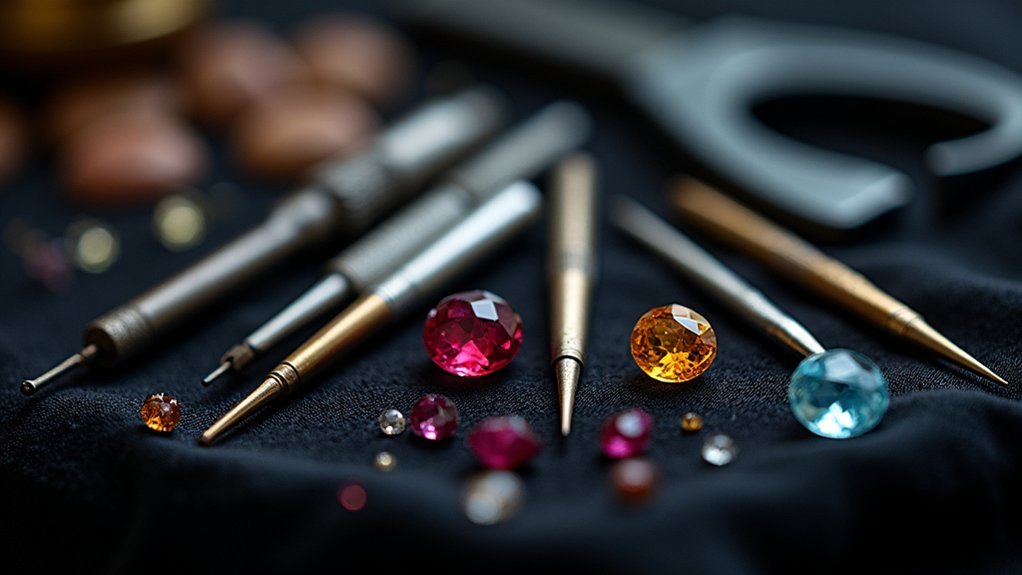

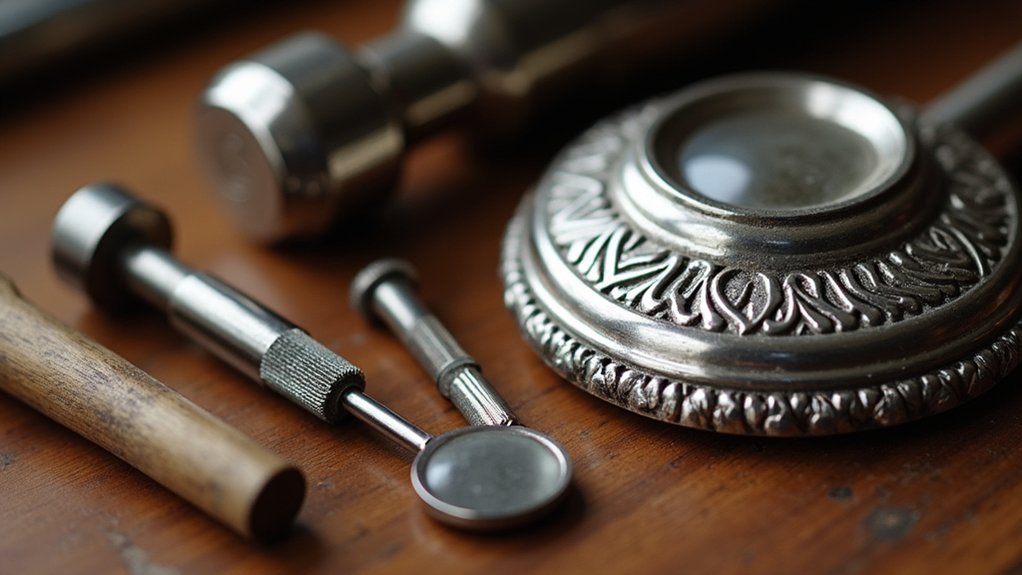
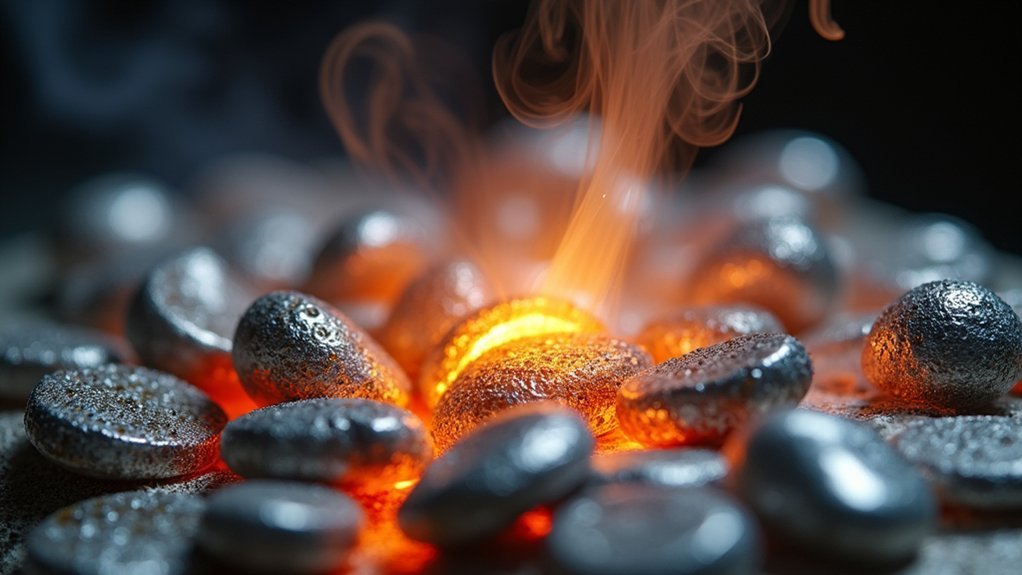
Leave a Reply